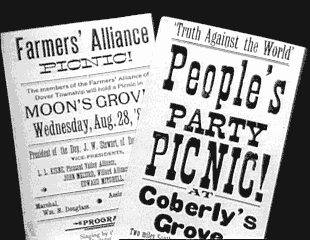The Farmers' Alliance
The Farmers' Alliance was an organized agrarian economic movement among American farmers that developed and flourished in 1875. The movement included several parallel but independent political organizations: the National Farmers' Alliance and Industrial Union, comprised of white farmers of the South; the National Farmers' Alliance, comprised of white and black farmers of the Midwest and High Plains (where the Granger movement had been strong); and the Colored Farmers' National Alliance and Cooperative Union, comprised of African-American farmers of the South.
One of the goals of the organization was to end the adverse effects of the crop-lien system on farmers in the period following the American Civil War. The Farmers' Alliance also generally supported the government regulation of the transportation industry, establishment of an income tax in order to restrict speculative profits, and the adoption of an inflationary relaxation of the nation's money supply as a means of easing the burden of repayment of loans by debtors. The Farmers' Alliance moved into politics in the early 1890s under the banner of the People's Party, commonly known as the "Populists."
Political Activism
The political activism of the alliances gained strength in the late 1880s as the organization merged with the nearly 500,000-member Agricultural Wheel in 1888. In the South, the agenda centered on demands for government control of transportation and communication in order to break the power of corporate monopolies. The Southern Alliance also demanded reforms of currency, land ownership, and income tax policies. Meanwhile, the Northern Alliance stressed the demand for free coinage of large amounts of silver.
Political activists in the movement also made attempts to unite the two alliance organizations, along with the Knights of Labor and the Colored Farmers' National Alliance and Cooperative Union, into a common movement. The efforts and unification proved futile, however, and the Southern Alliance organized on its own, eventually reaching 43 states. The alliance movement as a whole reached more than 750,000 members by 1890.
Formation of the Populist Party
The alliance failed as an economic movement, but it is regarded by historians as engendering a "movement culture" among the rural poor. This failure prompted an evolution of the alliance into a political movement to field its own candidates in national elections. In 1889–1890, the alliance was reborn as the Populist Party. The Populist Party, which fielded national candidates in the 1892 election, essentially repeated in its platform all of the demands of the alliance.
The Ocala convention was part of a trend in the farmers' movement to move from its fraternal and mutual-benefit roots toward an increasingly political and radical position. Convention delegates hoped that future political gains would lead to major economic and political reforms. The convention produced the "Ocala Demands," which included a call for the abolition of national banks, an increase in circulating money, free silver, industrial regulations, a graduated income tax, lower tariffs, and the direct election of U.S. senators.
In 1892, the Farmers' Alliance founded the People's Party, and the Ocala Demands were incorporated in the party's Omaha Platform. As the focus of the farmers' movement shifted into politics, the Farmers' Alliance faded away.

Farmers' Alliance pamphlets
The Populist Party grew directly out of the Farmers' Alliance. For both groups, social events helped cement political ties.